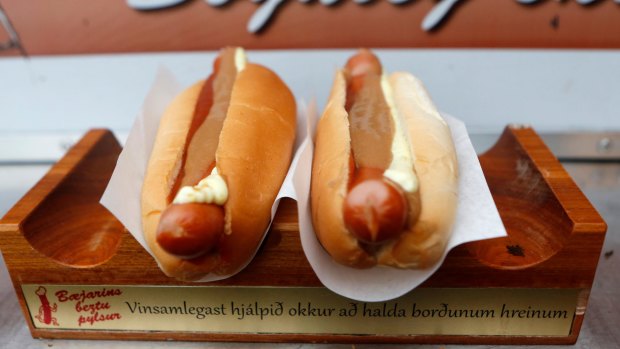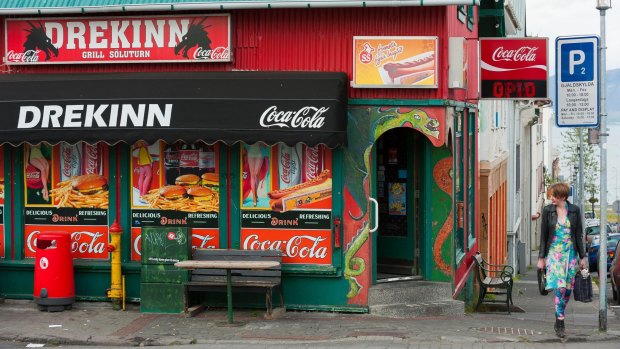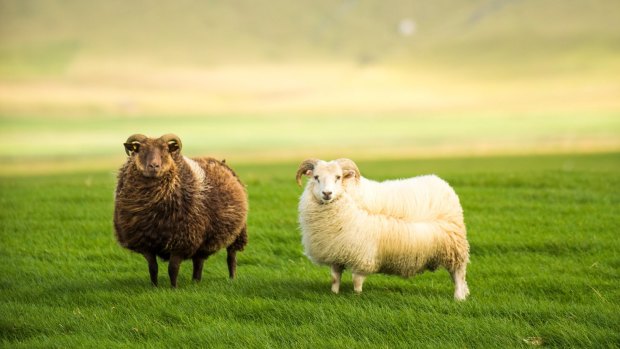This was published 1 year ago
How Iceland's popular hot dogs are different to American and Danish ones
By Anthony Dennis

What makes the Icelandic hot dog distinct from both the US version and the Danish one, is that the sausage meat used is manufactured from 80 per cent lamb with the remaining 20 per cent consisting of beef and pork.Credit: Alamy
The most common question posed by a visitor on arrival in Reykjavik, capital of the so-called Land of Fire and Ice, tends to be where are the nearest hot springs rather than where is the closest hot dog stand.
But it's an answer to the latter that I'm most keen to hear on arriving at my hotel in Iceland after a day and a half's worth of flying.
In a nation with a cuisine that includes rather less accessible delicacies such as fermented shark, blood sausage and - oh boy - foal meat, hot dogs, you see, are a curious feature of the Icelandic diet, a national institution in fact.

All those hot dogs are commonly rinsed down with a Coke. Credit: Alamy
Barely uttering a word, the receptionist points out the window beyond the bar to a long queue - something you don't see much in this scantily populated country - to, (bingo!) Iceland's most famous hot dog stand, Bæjarins Beztu Pylsur (in English, "The Town's Best Hot Dogs").
As frivolous as they may seem, an Icelandic hot dog can reveal almost as much about the nature of this country as its legendary thermal pools, where the water temperature ranges between 37-40 degrees Celsius (not quite hot enough to poach a hot dog sausage but getting there).
One theory proffers that the Icelandic hot dog can be traced to the significant American military presence here during World War II. That's when the Americans joined the British occupation of the island in moves to prevent the Germans establishing an Atlantic Ocean bastion.

There are far more sheep than cows in Iceland.Credit: Alamy
But Bæjarins Beztu Pylsur opened in Reykjavik 1937, when Iceland was still a Nordic dependency of Denmark, with the former not becoming an independent republic until June 17, 1944.
Anyone who has been to Copenhagen will have noticed a profusion of hot dog stands there as well.
Therefore it makes sense to believe the Danish most likely inspired the Icelandic version of the original American fast food. (In the US, hot dogs were originally called "dachshund sausages" and were first sold by a German immigrant out of a food cart in New York in the 1860s).
Yet with a national average life expectancy of 83.37 years, a combination of hot dogs and Coca-Cola - that other American staple of which the Icelanders are remarkably the world's highest per capita consumers - doesn't appear to be doing them much harm.
Back outside the Konsulat Hotel, towards the end of a winter-like summer's day, the earlier extended queue at Bæjarins Beztu Pylsur finally becomes as thin as a hot dog sausage itself.
The server inside the booth, surrounded by open-air picnic tables atop which little timber indented stands on which to balance your purchase perch, confirms my own research about the dog's contents.
What makes the Icelandic hot dog distinct from both the US version and the Danish one, is that the sausage meat used is manufactured from 80 per cent lamb with the remaining 20 per cent consisting of beef and pork.
What's more, the Icelandic lamb used as the main ingredient is organic, grass-fed and hormone-free, a far cry from the equivalent lingering in the tepid waters of notorious Australian hot dog stands sold outside sporting events.
This is explained by the fact that Iceland is home to far more sheep than pigs. In Denmark the reverse is overwhelmingly the case, with the Danes a major pork producer and exporter.
But one hot dog ingredient the two countries share are classic crispy fried onions and, to add a French touch, there's a squirt of remoulade, the classic mayonnaise-based cold French sauce.
If I hadn't already known that my hot dog sausage was made mainly from lamb I probably wouldn't have noticed that at a second bite it does taste just that little bit different to your standard dog. In fact, it's appetising enough for me to down a second (don't hold the ketchup).
However, man or woman can't survive in Iceland on hot dogs alone, though, come to think of it, you probably could.
There are, after all, multiple Bæjarins Beztu outlets in Iceland, as well as competitors, including one at Keflavik International Airport, where the US military was based.
The Americans probably felt understandably sheepish about a dog crossed with a sheep but imagine if the Icelanders had opted for fermented shark, let alone blood sausage, as the main ingredient. Bring on the hot pools, thanks.
Anthony Dennis travelled to Iceland as a guest of Norwegian Cruise Line and British Airways
THE DETAILS
CRUISE
A 10-day Northern Europe cruise from Reykjavik to England aboard Norwegian Prima departing in September, 2024, starts from $3420 per person. See ncl.com
FLY
British Airways flies daily to London Heathrow Terminal 5 from Sydney via Singapore with connections to Reykjavik. See britishairways.com
STAY
Rooms at the Reykjavik Konsulat Hotel start from about $A500 per night, depending on the season. See hilton.com
MORE
Sign up for the Traveller Deals newsletter
Get exclusive travel deals delivered straight to your inbox. Sign up now.